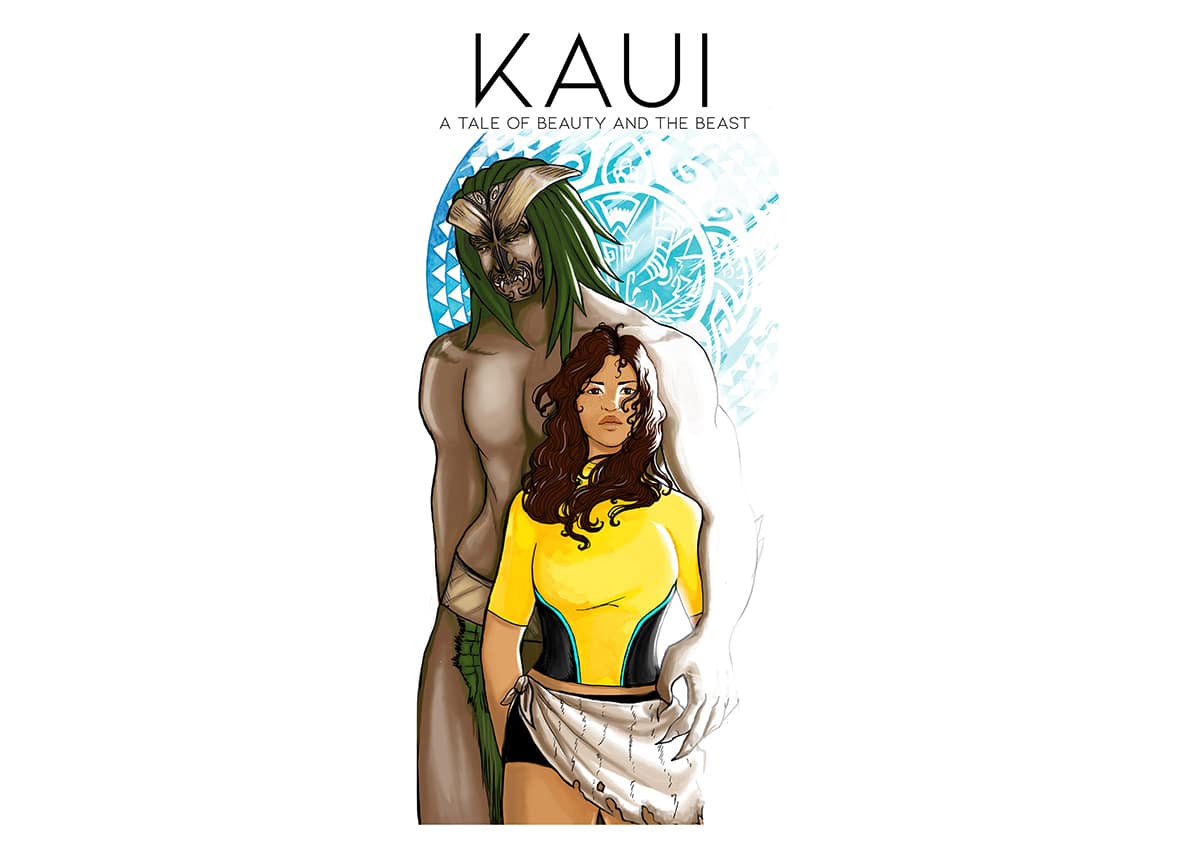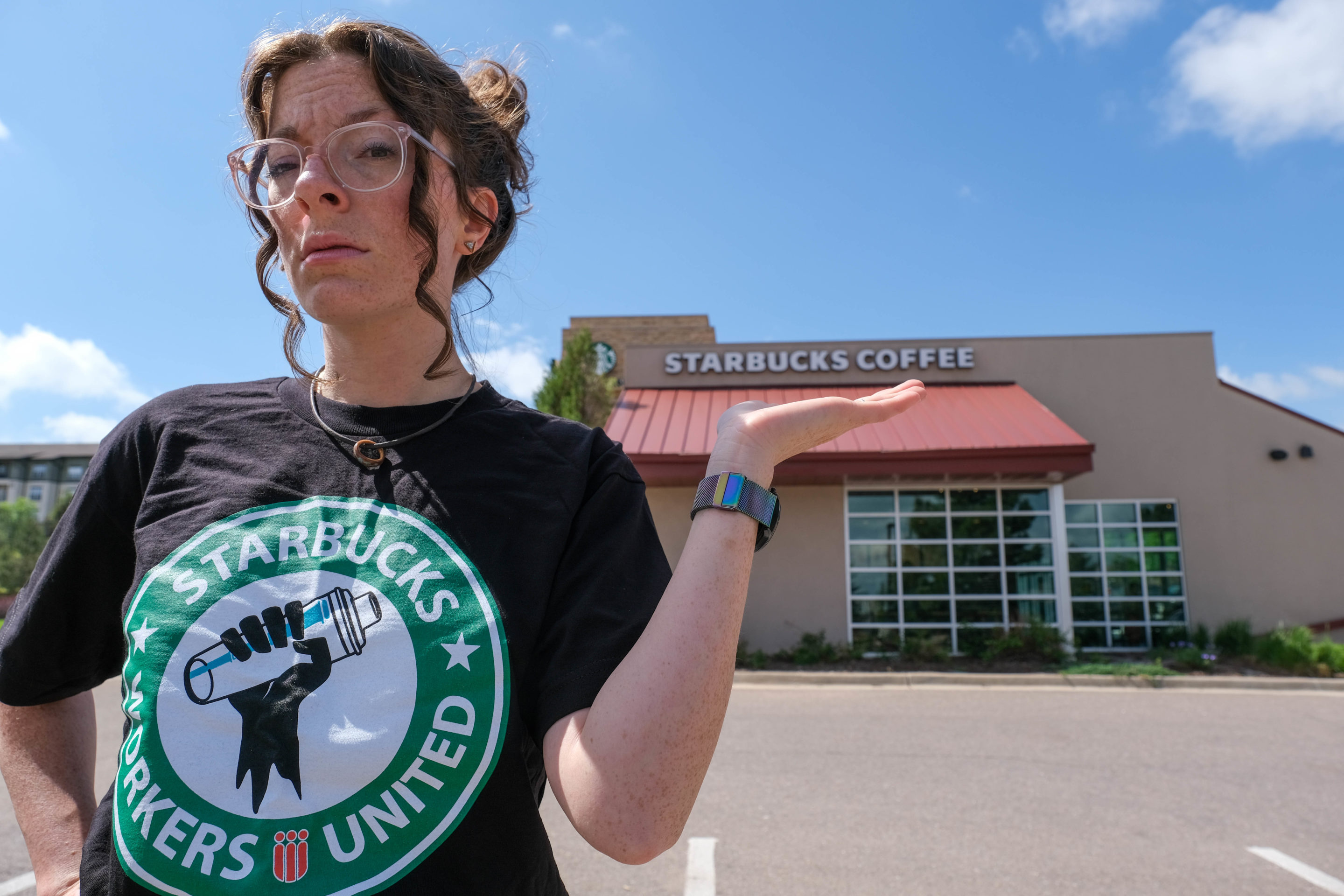//Artwork for the in-progress comic “Kauai: A Polynesian Tale of Beauty and the Beast,” a cross between the traditional French Beauty and the Beast and the Hawaiian story of Kamapuaʻa and the fire goddess Pele by Kristina Maldonado Bad Hand. Courtesy photo Kristina Maldonado Bad Hand.
It’s a story about unrequited love. Kamapua’a, Hawaiian Demigod, finds nothing but rejection from his family. His heart hardened three times over, and the people who share his volcanic island become the victims of his rage. One day, Pele the Goddess of Volcanoes and Fire arrives on the island, and for Kamapua’a it’s love at first sight. But will she return the affection he so desperately craves?
Kamapua’a’s story, of which several versions exist within Hawai’i’s rich tradition and folklore, serves as the basis for Kristina Maldonado Bad Hand’s comic, Kauai: A Polynesian Tale of Beauty and the Beast. The adaptation is a cross between the traditional French Beauty and the Beast and the Hawaiian story of Kamapua’a and Pele.
It’s also a story from a culture that doesn’t see much play in mainstream comics. But the push to expand representation isn’t new; today’s creators join a lineage of other artists that have expanded what and who comics are made for.
The first Black female cartoonist, Jackie Ormes, launched her career in 1937 with Torchy Brown in “Dixie to Harlem.” It featured a dynamic Black woman moving from the country to Harlem during the Great Migration. In the 1940s, Lily Renée illustrated Jane Martin, a female pilot in an all-male aviation industry. In the 1950s, Eisner Award-winning artist Ramona Fradon drew the chiseled muscles and quaffed hair of Aquaman. She reportedly had a crush on him.
Women in comics have put to page what they want to see, who they want to represent them, as they’ve done since the start of the industry. Their works continue to push the industry toward more complex, personal stories and inclusive practices.
Wendy Pini began her sojourn into comics in the mid-1970s with covers and illustrations for lauded magazines such as Galileo and Galaxy Science Fiction. By the end of the decade, she and her partner, manager and co-creator Richard Pini had begun the now 40-years-running indie series, Elfquest.
“I can’t honestly say that I turned to the women who were working in the mainstream for much inspiration because they were working with characters that had existed for a long time,” Pini said. “Richard and I were trying to forge our way, with brand new characters, a brand new kind of writing and art style.”
Comic readership in the 1950s and ‘60s was split 55% female and 45% male, according to the documentary, She Makes Comics. Fiction House, a pulp magazine and comics publishing company from the 1920s to the 1950s, was known for employing female creators and featuring strong heroines. Feminist comics historian Trina Robbins writes in The Great Women Superheroes, “They were war nurses, aviatrixes, girl detectives, counterspies, and animal skin-clad jungle queens, and they were in command. They did not need rescuing.”
Yet, as the industry boomed, major mainstream publishers like Marvel and DC focused almost exclusively on male heroes. Female creators felt neglected when it came to their interests and voices.
“The more superheroes took hold, the less anything else got priority,” said Janelle Asselin, former comic book editor and writer, in She Makes Comics.
Several female artists grew their craft in the underground comics scene. Lee Marrs, a pioneer in this realm, made The Further Fattening Adventures of Pudge, Girl Blimp from 1973 to 1977. The series went the opposite direction of thin, hypersexualized female characters and instead elevated the everyday life of a fat woman.
It is this same expression of female strength that many women embody at annual comic conventions through homemade costumes, extensive makeup and even foam weapons. While the revealing garb can be empowering for the wearer, others wrongfully take it as an invitation for ogling or physical advancements.
“I’m a big girl, I can take care of myself, but cosplay is not consent,” said one StarFest attendee in a 2019 Facebook post. StarFest is a convention based in Denver. She warned other cosplayers of a man who crashed her photo op and kissed her on the cheek. The poster later added, “take care. Know your boundaries. Speak up. Your cosplay community loves you.”
StarFest has a non-harassment policy online and asks folks to report to staff onsite. The broader movement of “Cosplay Is Not Consent” is designed to educate and inform attendees that cosplayers should have their autonomy respected.
Although these issues are increasingly discussed at conventions, Maldonado Bad Hand notes the spaces are not always empowering or safe for women. She points to a panel called “Women in Comics” at a past Denver Comic Con in which all the speakers were men, despite there being many female creators present on the floor. In contrast, she’s participated in panels about the hypersexualization of female characters to point out how many artists and readers are drawn with overtly-hourglass figures and posed for “the boob and butt shot.”
As with a generation of female artists, Maldonado Bad Hand’s entry to comics was through works such as Wendy Pini’s. Growing up, she and her siblings would look forward to unwrapping new editions of Elfquest for birthdays. Pini’s theatrical use of fore, middle and backgrounds provided her scenes with layers of meaning and foreshadowing. The pairing of images to words was also important for another reason.
“[ElfQuest] is probably the majority of what I read because I couldn’t really read words at the time,” she said. She is proud to be a forever nerd and credits comics’ visual cues, in part, for helping with her dyslexia. Today, Maldonado Bad Hand publishes independent works with her husband under áyA Studios.
Maldonado Bad Hand exists at another intersection of representation. As an Indigenous woman with Sicangu Lakota and Cherokee ancestry, she is critical of the way Native people are portrayed in the comic book industry, particularly when it involves the Pocahontas, Cherokee princess stereotypes.
“A lot of that goes hand in hand with actual issues that affect our communities, like missing and murdered Indigenous women,” Maldonado Bad Hand said.
Marvel’s Dani Moonstar stands out to Maldonado Bad Hand as an improved character and one of a few good examples of Native representation. The same is true with Echo, also a Marvel character. “From the get-go, her character was just really well thought out, even though there really weren’t a lot of Native people behind the scenes developing her,” Maldonado Bad Hand said. Echo will be played by actress Alaqua Cox (Menominee and Mohican nations) in the upcoming Hawkeye TV series.
The Pilla comic series, by Maldonado Bad Hand and her husband, is about an 8-year-old girl in post-apocalyptic Denver; Kristina inked and colored the project. But the upcoming Kauai comic was her brainchild.
“I wanted to see more representation of independent native stories because a lot of the time it’s a retelling of oral histories, or of stories that already exist,” Maldonado Bad Hand said.
The first time she released Kaui, some readers liked it, and people from Hawaii came back with critiques about inaccuracies and disagreements with representation. Instead of leaving things as is, Maldonado Bad Hand brought together a focus group in Oahu, brought on Hawaiian artist Vincent Kukua, and added 10 pages of references in the back of the book. Dealing with important stories but being from another culture, as Maldonado Bad Hand notes she is Lakota not Hawaiian, requires extensive research and is a major responsibility for any comic creator, mainstream or independent.
Other people of Indigenous descent are also enriching the comic scene, even if their contributions haven’t been recognized by the mainstream yet.
“The big publishing crowd could benefit from having more Indigenous people on board, not just as consultants but as people writing,” said Kayla Shaggy, a burgeoning Navajo artist. She wonders if big publishers are willing to go the distance; as Marvel did with its Indigenous Voices issue. “With the indie crowd, there’s more freedom and control.”
Shaggy’s first major (self-published) labor of love is The Sixth World series, a tale about a young Navajo woman living on Mars 200 years from now. It looks at the future of Indigenous identity, with parallels between the displacement from Earth and Native peoples’ displacement from their lands in the U.S.
“[I was] hunkering down and talking to my parents about Diné stories, and looking at translations and symbolism, the things mentioned in our culture,” Shaggy said. “As well as thinking seriously about what kind of story I want to convey—not just to Indigenous people but to all sorts of people. It became a story that has a lot of Indigenous culture in it, as well as social commentary and the science fiction genre.”
The title, The Sixth World, refers to a Diné origin story in which people emerged from the first four worlds, and the fifth world is where holy people reside. Presenting a sixth world, according to Shaggy, brings forth the question: “What if there’s more than we originally thought?”
There was surely more to the comic world than Shaggy originally thought. As a kid, her grandmother introduced her to comics as a way to learn English and treat her speech delay. Shaggy’s grandma was a fan of Generation X for its diversity, her uncle was an avid collector of Carnage and Sabertooth and her dad was fond of Shazzam. Shaggy gravitated toward some Marvel and DC, and more than anything, manga.
“Whenever I would go to the library, I would just go to the comic section and try to read everything to try to get an idea of the different forms and the different genres,” Shaggy said. She was aware of a growing desire to see more characters that were genuinely like her. “As I learned more and more about it, and saw that a lot of these Indigenous characters in comics are falling into these stereotypes.”
Delving more into the independent comic world, she found out about Indigenous Comic Con. There, in Albuquerque, she met Kristina Maldonado Bad Hand and saw more Indigenous comics and artists.
As a marginalized creator, Shaggy has experienced people trying to silence her, talking down to her and making her feel embarrassed for her work.
“That type of gatekeeping really hurts the potential of more diverse voices coming into comics,” she said. “People have this established idea of what comics are and of the people making them. I’ve encountered people who didn’t want me [at book signings and conventions] because I didn’t meet the guidelines or something like that.”
Shaggy’s advice to others? Make work that speaks to people in their communities, and it will be appreciated. Keep working, even if others think it’s not successful.
“The one thing that really gets me to keep going is when people tell me, ‘I bought your comics for my child, and it just made them want to start drawing, or they’re making their own comic.’”
Enjoyed this story? Help us keep the lights on! Supporting local press ensures the stories you want to read keep coming, become a member for free today! Click here.





0 Comments